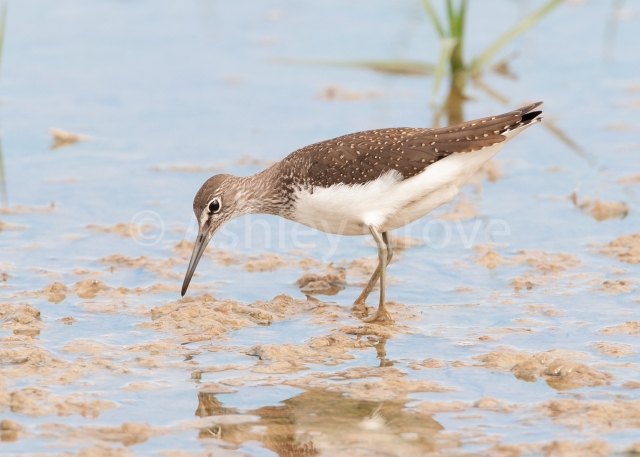Well here we all are, spending a lot more time at home than we’d bargained for this Spring. Wildlife enthusiasts across the country will be tearing their hair out, wondering what they are missing on their local nature reserve, or what new wildlife they might have seen on that cancelled holiday, but this is in many ways the perfect opportunity to find out exactly what we have in our own backyard.
Even if you have a small garden, or maybe non at all, we all have a view outside and with Spring migration in full flow, birds moving north into the UK to breed, could be passing through your airspace, dropping into some adjacent scrub, or even right into your garden.
Only this morning I had an email from some friends, who have a Ring Ouzel in their Norfolk garden today. This couple might well have been abroad this week if things had been different and would have missed out on an incredible garden record. You may be thinking, well that never happens to me, but you’re more likely to find out over the coming weeks, you never know your luck.

Ring Ouzel
Currently Ospreys are moving north to breed, of which there have been numerous sightings over this weekend just gone, even a few sightings of Common Cranes as they perhaps take a detour across the UK, en-route to Scandinavian nesting sites.

Common Crane
Personally over the years I’ve seen some unusual birds from my window or the garden during times of passage, Short-eared Owl high over Hall Green, Birmingham, Reed Warbler, Grasshopper Warbler and Common Redstart, all dropped into the railway embankment at the rear of my house in Solihull for day visits.
Its just a case of being in the right place at the right time and lets face it, we’re going to be in the right place, for a long time yet…
Some birds migrate at night of course and there is some interesting reading out there on ‘Noc-migging’, which is worth googling. For example sound recordists have picked up thousands of Common Scoter passing over the UK mainland during the first few days of April, perhaps being easier to detect with the lack of road noise of late.
You may think that birds are unlikely to be in your neighbourhood, so perhaps this might make you think otherwise? In a previous life I worked in Birmingham wholesale market, where I imported flowers from around the world and sold on to florists. Its a line of work that rather governs your life style, early to bed and up well before the lark, to start work, sometimes as early as midnight.
Working in a covered area like a huge barn, with huge doors at either end, you couldn’t see the sky, even when it finally got light, not even an office window to sneak a peak out of to see what might be flying by. Plus being close to the city centre, it was always going to narrow down the range of birds one was likely to see.
However, every now and again, I’d catch a glimpse of something to brighten my day, a Robin perhaps, or the dash of a Sparrowhawk on the look out for a docile feral pigeon, I once even saw a hopeful Kestrel inside the market, which can only have been on the look out for mice.
My top ‘market’ bird though was such a surprise, if I asked you to guess what it was, you’d probably real off a list of half of Britains bird species and still not get it. One dark Autumn morning I’d not long started my shift, around 2am and was putting together orders to be delivered that day, when my ears pricked up to a familiar bird call. However, it’s a bit like when you see someone you know, but you can’t remember where you know them from, as that face fits with a different place.
Well this bird call certainly didn’t fit with the concrete, indoor environment of Birmingham wholesale market thats for sure.
The bird was a Green Sandpiper, a wading bird, but so far from any water. Migrating at night, it must have been drawn in by the lights, possibly even forced down by a hunting Peregrine Falcon, which have become night time predators in some city centres, using the street lights to observe prey, moving through at night.

Green Sandpiper
So in some ways, this could be the perfect time to be homebound, as the birds could just come to you. Have your binoculars at the ready, make the most of the lower traffic noise and listen for bird calls and song and who knows what you might observe.
Start keeping a daily log of bird sightings and use the time to familiarise yourselves to the sounds of our common birds. The basis to my birdwatching expertise, was getting to know the familiar birds from my own experiences, then the wider you travel, the knowledge you have of the common birds, will help you narrow down the new birds you see, to the right species and this will aid a positive identification.
I’d really like to hear from people with their own ‘lockdown bird sightings’, so please follow the blog and post comments below.


Had a lovely little Egret yesterday on the river Sowe by me yesterday . Normally an area inundated with dog walkers and teenagers doing the noisy stuff that teenagers do. Just goes to show how a little less disturbance can make all the difference.
LikeLiked by 1 person
Great to hear Denis. We get regular Little Egrets on the stream near us. A species on the up for sure.
LikeLike
Very interesting Ashley x
LikeLiked by 1 person
Glad you like it Joan. Hope you’re both keeping your heads down. Take care x
LikeLike
Never before seen in my garden, a nuthatch, and at the weekend a blackcap. The pleasure of watching blue tits nesting for the first time in a box I put up 2 years ago is some consolation for not joining you for the Sweden trip later this week x
LikeLiked by 1 person
You see, so much on our doorstep, we don’t usually have the time to enjoy. I’ve been photographing Jackdaws collecting sticks for their nest this morning, great fun! This time next year, we can do Sweden, the Cranes will be waiting for us x
LikeLike
Thanks Ashley. Take care and stay safe
LikeLiked by 1 person
Thank you for reading. Take care too x
LikeLike
We have lots of little egrets in Birmingham now whereas five years ago when I took this photo they were quite scarce.
LikeLiked by 1 person
Nice capture John. You’re right, it’s hard to believe they first bred in the UK a little over 20 years ago and there has to be upwards of 1 million pairs now. Good to have a success story for a change. Thanks for messaging.
LikeLike